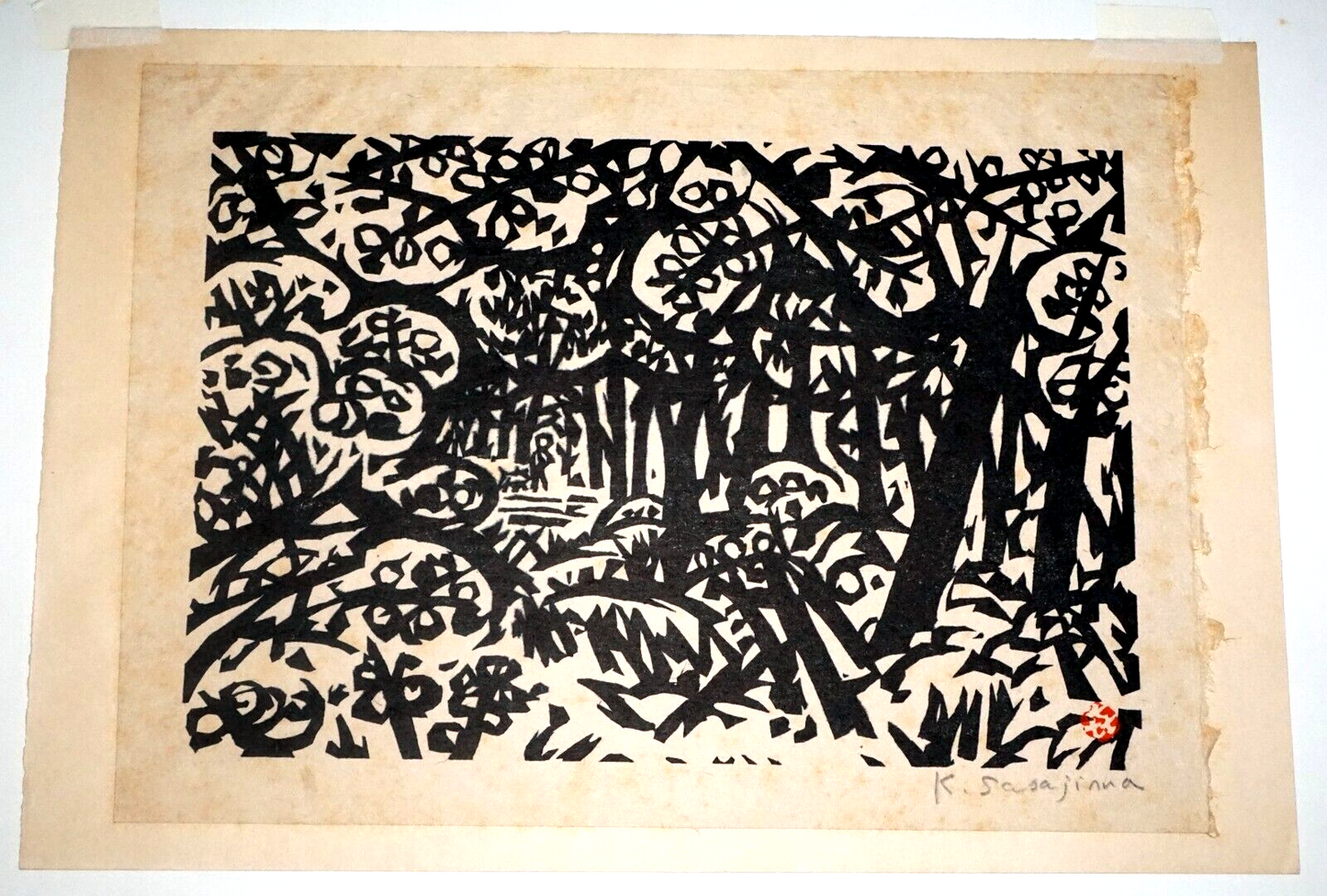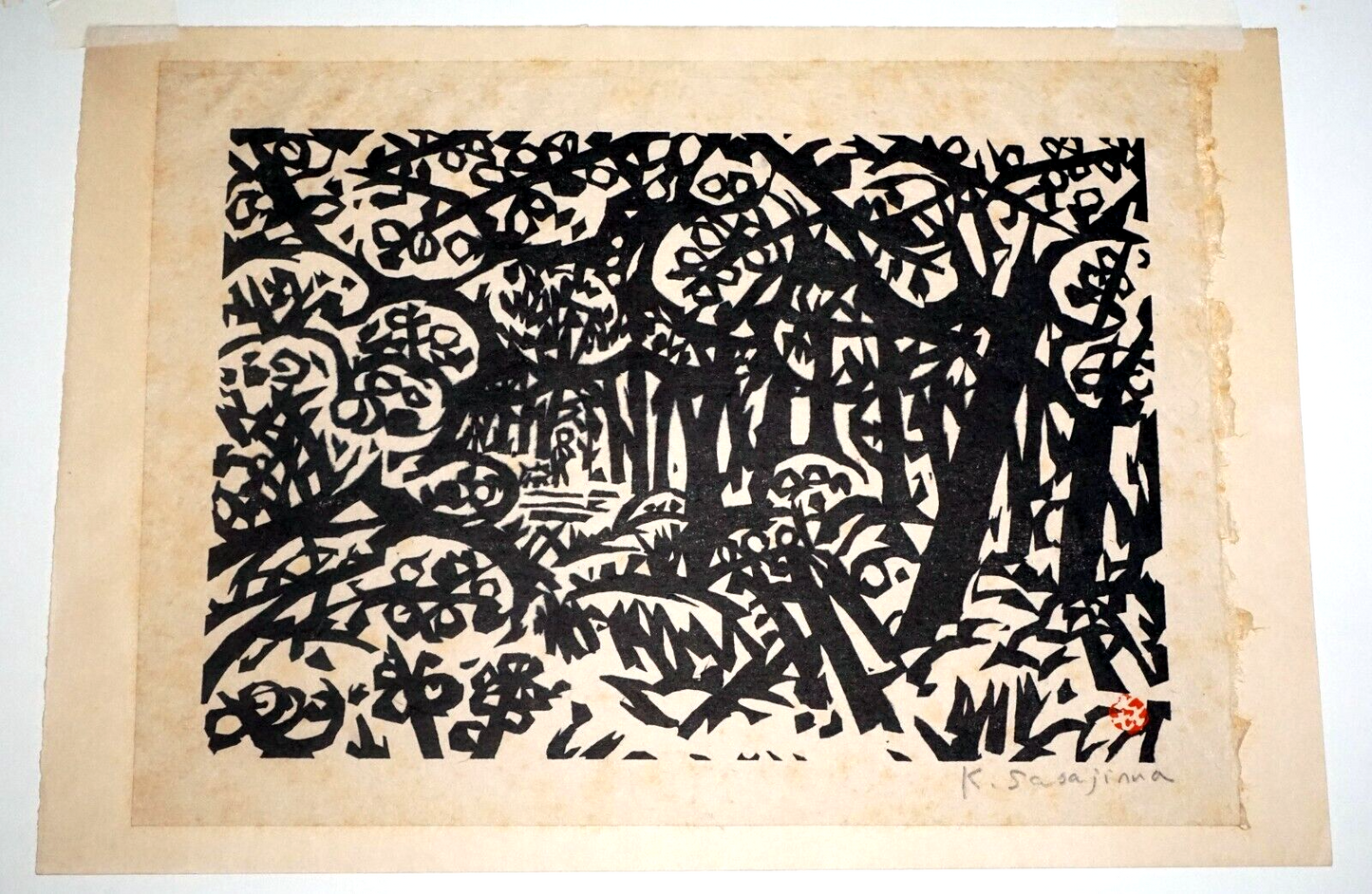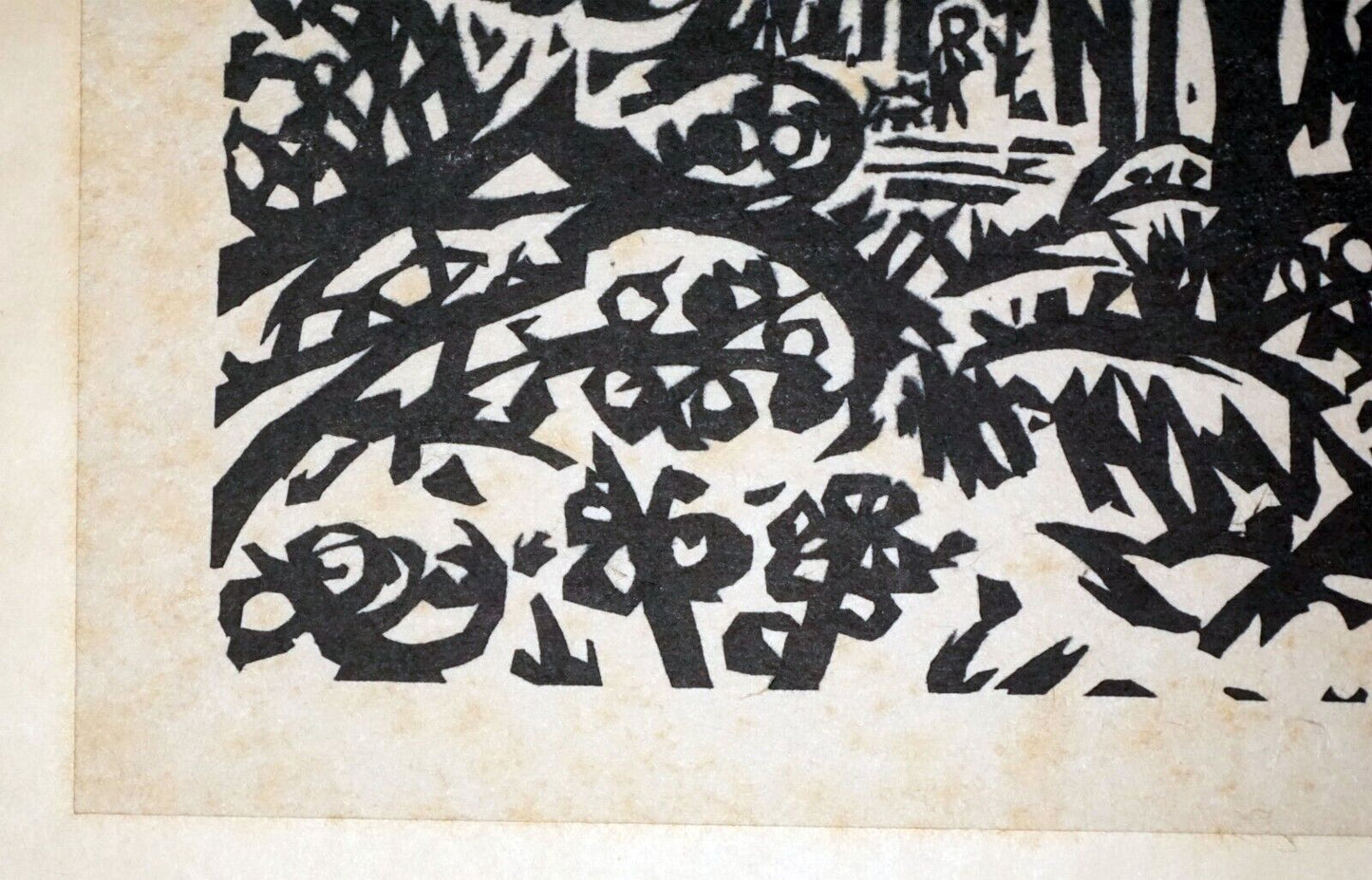Harnisch and Company
'70s Japanese Woodblock Print In the Forest by Kihei Sasajima (1906-1993)(SeF)
'70s Japanese Woodblock Print In the Forest by Kihei Sasajima (1906-1993)(SeF)
Couldn't load pickup availability
Share
Up for sale from a recent estate in Honolulu Hawaii, this 1970s Japanese open edition embossed black and white woodblock print that is titled "In the Forest" and was created by the well known artist Kihei Sasajima (1906 - 1993). The condition is described above for more information please check the photos. Free local pick up possible!!!
Measurements:
Print 8 inches x 11 ¾ inches
Frame 9 ¾ inches x 13 ⅜ inches
More about the artist:
Sasajima Kihei (笹島喜平 1906-93) was born in Mashiko (益子), Tochigi Prefecture, north of Tokyo. The town has been a well-known production site for a rustic-style pottery since the mid-nineteenth century, and it was where the great potter Hamada Shoji (濱田庄司 1894-1978) settled in 1924 (he was later designated a Ningen Kokuhô, "Living National Treasure," 人間国宝). Sasajima thus benefited from direct connections to the Mingei (folk art: 民芸) movement. Sasajima's first formal training began when he moved to Tokyo in 1927 to attend the Tokyo Prefectural Aoyama Normal School (later merged with other schools into the Tokyo Gakugei University, 東京学芸大学). After completing the course, he taught in elementary schools until 1945, while also studying oil painting, calligraphy and drawing. In 1935, he took an extracurricular printmaking course given by Hiratsuka Un'ichi, whose monochrome printmaking served as a model for Sasajima to follow for his entire career. Then, in 1938, Hamada Shoji introduced Sasajima to Munakata Shikô, who became an enduring influence upon his work. Sasajima did not find Munakata to be an especially effective teacher in the usual sense - the life-force of an artist was more an inspiration than a source for particular tutorials in making woodcuts. Sasajima once told the collector, print connoisseur, and author Oliver Statler (see biblio.) that he was in awe of Munakata and found him overwhelming, but nevertheless, he did learn a lot. Sasajima believed that his love of monochrome prints came not only from his studies with Hiratsuka and Munakata, but also from Japanese calligraphy as well as painters of the Nanga-ha (southern-style Chinese literati school: 南画派) or nanshûga (南宗画) - he cited Ike no Taiga (池大雅, 1723-1776) and Tomioka Tessai (富岡鉄齋 1837-1924) among those whom he admired. Sasajima also pointed out that as he worked on prints at night (the only time he had free from teaching), black & white seemed best when working under artificial illumination.
Sasajima met another leading artist, ri Yoshitoshi, in 1940, the first year Sasajima exhibited at the Kokugakai (National Picture Association: 国画会). From 1945 he worked as a print artist, primarily in monochrome with occasional forays into color. He became a member of the Nihon Hanga Kyôkai (Japan Print Association: 日本洋画協会) in 1948, but withdrew to join Munakata to assist him in founding the Nihon Hanga-in (Japanese Print Institute: 日本板畫院) in 1952. His career began to take off in the West when Oliver Statler presented his prints in Modern Japanese Prints: An Art Reborn (1956). He received wider acclaim when his work was exhibited at the Second Ljubljana International Print Biennale in Yugoslavia in 1957, as well as at the Tokyo International Print Biennales from 1957 through 1966. In 1959 he also had a two-person show in Washington, D.C., with Hashimoto Okiie.
After an illness in 1959, Sasajima lost the strength to rub woodcut impressions into paper with the traditional baren (bamboo-pad rubbing tool: 馬楝). As a result, and inspired by stone-rubbing, he developed a technique of forcing paper into a deeply cut block with the aid of an etching press and then applied sumi ink using the takuzuri - shittaku (damp-method rubbing: 拓刷り 湿拓) to the remaining unpressed parts of the design. This involved dabbing the raised areas with ink-soaked pads or a tanpo (rounded printing tool wrapped with cloth: たんぽ). In effect, the inked design now resided on what would have been the reverse of the paper had Sasajima made his prints in the traditional manner. The resulting raised-relief or three-dimensionality made his prints distinctive and popular. The view of Mount Fuji (富士口) shown at the top of this page was made at a time when Sasajima's career was in full bloom. Published in an edition of 75, the image measures 452 x 452 mm and shows to great advantage the embossing technique that he developed (see further discussion below).
Sasajima's early woodcuts tended to be fairly straightforward in design and execution. Among these works were images published in dôjin zasshi (coterie magazines: 同人雑誌). A small view (image: 130 x 165 mm) of Sotobô (外房) on the east coast of the Bôsô (房総) peninsula from 1942 appeared in volume 1 of Kitsutsuki ("Woodpecker": きつつき); see immediately above. The magazine was originally published only in 1930-31, but was revived in the year of Sasajima's publication by the Kitsutsuki Print Club under the title Kitsutsuki hanga-shû (Woodpecker print collection: きつつき版集画集). Created while Sasajima was still teaching in elementary schools, the scene uses simple forms and relies on a silhouette effect that partly resembles a stencil print in its rendering of the landscape.
In 1948 Sasajima was commissioned by the Mitsukoshi Gekijô (Mitsukoshi Theater: 三越劇場) to create a series of kabuki prints for their productions. These small works (approx. 185 x 240 mm down to 75 x 140 mm) included both single-actor portrayals and full stage scenes in a simple, naive style. Some of these black and white designs were hand-colored by brush on the reserve sides of the prints, relying on the bleed-through of bright pigments to reveal much subdued coloration on the front. Sasajima was, no doubt, using a technique learned from Munakata Shikô, who first used urazaishiki ("back coloring": 裏彩色) in 1938. Additional kabuki subjects appeared in 1949 when Sasajima produced a book of prints based on a kabuki adaptation by Watanabe Katei from 1909 of Chikamatsu Monzaemon's (近松門左衛門) 1721 puppet play Onna goroshi abura no jigoku (The woman-killer and the hell of oil: 女殺油地獄) which he submitted to the twenty-third Kokugakai exhibition.
One of the two designs illustrated in Statler's book (see biblio.) is known as "Mountain Stream" from 1954. Sasajima used one block of plywood faced with shina (Japanese basswood: 科), which he inked with sumi and printed in a single stage. Sasajima told Statler that this view was a mountain stream near the Atsushio hot spring in Aizu. There is a strong sense of motion and vigorous growth in an untamed natural setting. The deep black sumi seems a perfect match for the intensity of the scene.
Sasajima did not produce much work in color, but on occasion he found reasons to do so. This sometimes happened, for example, when he submitted or was invited to contribute small-format prints to art magazines. One such example is shown below left, a group of three female bathers at a beach, as issued in the poetry magazine Keisei in the 1950s. Using three colors, Sasajima arranged the bathing beauties under an awning or large beach umbrella, rendering their postures accurately and effectively. He did not, however, attempt to create realistic facial features; instead, he gave each figure only a blue streak of pigment for a nose.
Sasajima would also create still lifes such as the vase and grapes design shown below right. A print of modest size (image: 302 x 210 mm), the view offers a multiple-perspective rendering of objects and forms space, with the vase seen head-on, the cluster of grapes seemingly suspended in ambiguous space, and the black form (possibly part of a table top, or perhaps merely an abstract shape), seen from above. Cubism had half-a-century before been introduced into the art world, but still, perhaps Sasajima was taking his cues from those European models of semi-abstraction, or from Japanese artists who had done so.
In 1967 Sasajima's 188-page book of essays on art, titled Ichijin, Sasajima Kihei gabunshû ("First dust: Sasajima Kihei's book on art": 一塵 笹島喜平画文集), was published in Tokyo by Kabushikigaisha Bijutsu Shuppansha (Art Publishing Company, Ltd.: 株式会社美術出版社). In 1990 he was chosen by Tochigi Prefecture as a Bunka kôrôsha (Person of cultural merit: 文化功労者), winning the Lifetime Achievement Award for distinguished service and outstanding cultural contributions toward the advancement of fine art.
Sasajima Kihei Hall, in the Mashiko Museum of Ceramic Art located in Sasajima's birthplace, holds a collection of nearly 300 prints and 200 sketches by him. Before then, the museum had opened in 1993 to collect and exhibit works by potters representative of the town of Mashiko, such as Hamada Shoji (濱田庄司 1894-1978) and Hamada's student Shimaoka Tatsuzô (島岡達三 1919-2007), both of whom were Living National Treasures, as well as other potters with connections to Hamada. The museum also collects the works of the British potter Bernard Leach (1887-1979) who in 1919 first met and then became a life-long friend and colleague of Hamada. The museum also collects works by artists from the early stages of the Leach Pottery near St. Ives in England (founded in 1920 by Leach and Hamada), and modern ceramic art from the West. Thus a hall in this ceramics museum devoted to the prints of Sasajima Kihei is surely a notable exception made in honor of their native son.
Works by Sasajima can be found in the Art Institute of Chicago; British Museum, London; Hamamatsu Municipal Museum; Harvard Art Museum, Cambridge, MA; Mashiko Museum of Ceramic Art; Museum of Asian Art, State Museums of Berlin; Museum of Fine Arts, Boston; National Museum of Modern Art, Kyoto; National Museum of Art, Osaka; National Museum of Modern Art, Tokyo; and Tochigi Prefectural Museum. © 2020 by John Fiorillo
Condition:
The item is overall in acceptable pre-owned condition, even toning and brown spotting throughout, the piece can be cleaned as per my paper conserver
















